#microclimates
Explore tagged Tumblr posts
Text
Excerpt from this story from The Revelator:
Saudamini Mohakud, the 65-year-old elder of her village, proudly calls herself the daughter and bride of the Eastern Ghats, the range of mountains that borders the eastern Indian state of Odisha. The mountains’ undulating wooded hills cradle her native village, Punasia, where she was born and wed. Saudamini says she could not have been happier growing up in its lap of lush greenery, which included about 50 acres of the community forests near her village.
“The forests were then a treasure trove of nature’s bounties, providing us with fruits, vegetables, tubers, medicines, and numerous other resources that sustained our households,” says Saudamini, now a grandmother to four children. “Our sacred grove, dedicated to our village deities, also flourished within these community forests.” The village cattle, too, grazed at the edge of the forest and community pastures.
But in the 1980s the forests began to disappear. The hills turned bare. According to villagers, loggers rampantly smuggled timber. Summers became hotter; dusty winds from the nearby hills hit the village. Rainfall became scarce and erratic. Agriculture, their primary means of livelihood, became uncertain. Depleted forest resources also hit their secondary source of income: collecting seeds, mushrooms, flowers, and other wild plants.
By the 1990s Punasia’s economy was as bare as the nearby hills. “This resulted in migration of men and youths from our village to find work outside,” rues Saudamini.
But over the past two decades, Punasia village has turned that around. A dedicated band of women led by Saudamini have nurtured nearly 50 acres of degraded forest patches and restored them to their former glory.
The formerly depleted forests have regrown with native trees such as sal, siali, mahua, tamarind, mango, and bamboo. Natural water bodies have also been revived with regular rainfall and rising water tables.
“It was hard work” that relied upon their traditional knowledge, recalls Mami Mohakud, now 35 and a member of Saudamini’s team. “We reared the reappearing saplings in the forests, created fences around them, and saved them from grazing cattle.”
Saudamini’s 20-year-old granddaughter, Nirupama, says these protected and restored community commons are an intrinsic part of Punasia’s existence, spiritual, cultural, and ecological heritage, as they are for other Indigenous communities. “They are not just forests or grazing land for us, but deeply connected with our feelings, sustenance, and day-to-day life,” she says.
Community commons also provide many ecosystem services that regulate the local climate, a process seen around the world, according to Sharat Kumar Palita, a professor in the department of biodiversity and conservation of natural resources at Central University of Odisha, Koraput.
“Different kinds of commons — including forest patches, water bodies, and grazing lands — play their respective roles in maintaining favorable microclimatic conditions,” says Palita.
3 notes
·
View notes
Text
Reverse Urban Gardening: Transforming Indoor Spaces into Green Oases
Ever wished you could step into a lush garden without leaving your home? With reverse urban gardening, you can! Bringing the Outdoors In: The Magic of Reverse Urban Gardening In cities where outdoor space is a luxury, gardening lovers are flipping the script—bringing nature inside instead of struggling to find a patch of land outside. This is called reverse urban gardening, and it’s all about…
#GrowPlantsIndoors#IndoorGreenSpaces#Microclimates#ReverseUrbanGardening#UrbanJungle#Lmsint medai 2025
0 notes
Text
The Mysterious Circular Terraces of the Incas This place is called Moray, an archaeological site in Peru that contains Inca ruins. It is located approximately 50 kilometres (31 mi) northwest of Cusco, on a high plateau at about 3,500 metres (11,500 ft) above sea level. The site is known for its circular agricultural terraces, which were likely used by the Incas to experiment with crops and create different microclimates. Some experts believe that Moray was a kind of experimental farming laboratory, but its exact purpose is still being explored and debated. Moray is a UNESCO World Heritage Site and a popular tourist attraction in the Sacred Valley of the Incas.
Untitled
View On WordPress
0 notes
Text
"A recent World Meteorological Organization report called heat waves the “deadliest meteorological hazard” from 2015 to 2019, affecting people living on all continents, and setting new national heat records in many regions.
Canada’s top weather event in 2021 was British Columbia’s record-breaking heat, according to Environment and Climate Change Canada. The temperature in Lytton, B.C., hit 49.6 C on June 29. The following day a wildfire destroyed 90 per cent of the town, killing two people and displacing 1,200 others.
Heat waves also exacerbate existing health issues, including cardiovascular and respiratory disease. They’re associated with increased hospital admissions, psychological stress and aggressive behavior, as well as excess mortality.
During heat waves, the highest temperatures are often found in urbanized areas. Urbanization is almost always associated with an increase in paved, impervious areas, and often a decrease in greenery. Concrete and asphalt roads, and other built materials readily absorb, store and release heat, raising city temperatures, a phenomenon called the urban heat island.
Many studies have shown that urban forests can reduce the urban heat island, and many policies focus their attention on large green spaces.
Small green spaces, such as yards, rooftops and small parcels of undeveloped land, can make impressive contributions to lowering urban heat, but they are often overlooked when developing strategies for urban cooling.
The effect of small green spaces
Cities rarely have the opportunity to add large green spaces to help counter the effects of heatwaves. Smaller vegetated spaces, however, can still meaningfully decrease local land temperatures.
Small green spaces, such as yards, rooftops and small parcels of undeveloped land, can make impressive contributions to lowering urban heat, but they are often overlooked when developing strategies for urban cooling.
A recent study in Adelaide, Australia, found that tree canopy cover and, to a lesser extent, grass cover decreased local daytime surface temperatures by up to 6 C during extreme summer heat conditions. Further inland, suburban yards and gardens can decrease local surface temperatures up to 5 C.
At a quite small scale, on the order of tens of square metres, trees reduced daytime surface temperatures twice as much as grass cover. But grass and other small, low-lying plants, grow relatively quickly, compared to trees.
Cities should adopt short-term and long-term strategies to respond to extreme heat, including the replacement of paved and impervious surfaces with grasses and turf, and increasing tree plantings to boost canopy coverage.
Amplifying the cooling effect
Furthermore, when managing small green spaces, city planners and foresters can select tree species based on their ability to cool the environment. Green spaces with a high diversity of tree species have a greater cooling effect in spring, summer and fall. They also have a larger maximum drop in temperature in the summer, compared to spaces that are less diverse.
For example, tree canopies with large leaves and high transpiration rates — the evaporation of water from plants occurring at the leaves — could provide more cooling.
Planting a variety of species, of different heights, can have a larger cooling effect than tall trees alone.
The structure of green space may also influence its cooling efficiency. In summer, a plant community with multiple layers of trees, shrubs and herbs can further decrease air temperature by 1 C on a sunny day and 0.5 C on a cloudy day, compared with an area only dominated by tall trees...
But overall, trees usually have a stronger effect on cooling than grass. Planting trees in groups, not individually or in lines, is recommended for regulating the microclimate (local climate conditions near the Earth’s surface).
Small green spaces can offer a lot of summer cooling in cities. And cities can learn to manage the configuration of small green spaces better to get more cooling benefits and minimize the trade-offs."
-via GoodGoodGood, July 4, 2024
#green space#urban#urban landscape#urban forest#urban green spaces#food forest#permaculture#gardening#microclimate#cooling#conversation#global warming#climate change#climate action#solarpunk#rooftop garden#ecopunk#meterology#ecology#ecosystems#environmental science#plant trees#good news#hope
872 notes
·
View notes
Text
Spring from The Seasons by Alphonse Mucha? Yeah, it's that but Zagreus.
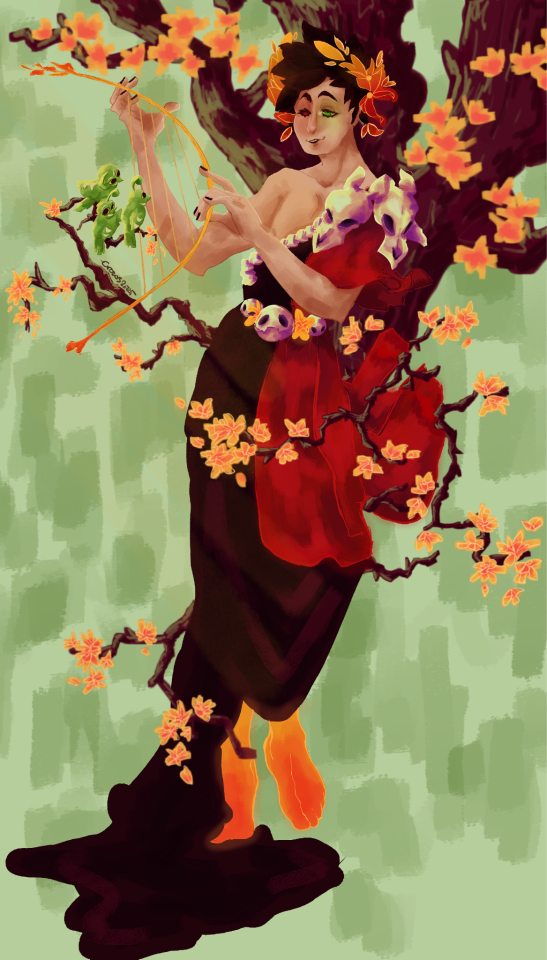
#“Artemis can i borrow your quails?”#no but they're really cute guys#The vibe of this hilariously clashes with the in-game music that Zagreus plays on the lyre#Also i don't know if there's a flower species that actually matches these#or if there is - if they're spring flowers#let's just say they are (in a fantasy world)#I am very late but Hades is too good and i absolutely had to draw something for it#I might dress up the pretty boy in other seasons#He deserves to experience something besides grandmom's winter and mom's cottage microclimate#hades game#hades supergiant#hades#zagreus#hades zagreus#inspired by The Seasons by Alphonse Mucha#art by me#hades fanart#digital art
44 notes
·
View notes
Text

I have a foolish little blue cardinal flower still blooming in a somewhat protected area of my yard. Does it realize it was below freezing out this morning? Does it know that it's nearly December? The hummingbirds are long gone and bees are hibernating. Get your shit together weird cardinal flower.
#it's not even protected under anything it's just in an odd microclimate i guess#garden content#lobelia
31 notes
·
View notes
Text
Worldbuilding challenges I did expect: History and political environment.
Worldbuilding challenges I did not expect: I, a soil & geology student, accidentally getting side-tracked and fixating on developing the area's climate, geological buildup, geological history and development, current geological phenomena, geological relations to land use, land use in economical and trading context, influences of climate on said land use, I could go on.
#okay but cliffs scoured out by the claws of an ancient beast sound COOL#i need a microclimate on a specific mountain for specific reasons#that dead enchanted forest has no purpose YET#for specific purposes there must be gemstones and gold mining#discuss: shallow warm sea on the west coast or a tundra in the north#because i can't have both#it wasn't gonna be a delta setting i swear#do i want snow on the mountains??#that would affect the aforementioned microclimate#MORE geological structures originating from ANCIENT BEASTS because that's COOL
21 notes
·
View notes
Text
"There are no flowers on Tatooine. Luke's never seen a plant before. The desert is a wasteland."
THEN WHAT ARE THEEEESEEEEE
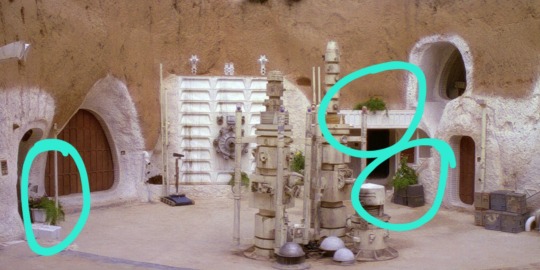

#coughs blood please im begging you. do some research regarding desert ecosystems and culture and also SCREENSHOTS before making up fanon#like. yeah theres no plants around the homestead because they literally live on a SALT FLAT#and like. some of the most resource poor cultures in existence go HAM on aesthetics because beauty and enjoyment is#integral to the human experience.#like personally i choose to believe those flowers/plants are edible bc the reality of tatooine means that i doubt water would be used#purely for decoration. but like. what if it was. what if those are hardy native plants that thrive in the microclimate of cave houses#that beru or shmi planted just because they could. what then. life is so hard but sometimes thats when you need beauty the most.
16 notes
·
View notes
Text

Carruthers Street, Manchester.
5 notes
·
View notes
Text
Water in landscape design

Water in landscape design creates balance and harmony, bringing freshness and serenity, and enhancing the microclimate of contemporary architecture. Elements like water mirrors in courtyards, paired with local vegetation and soft lighting, invite reflection and calm. These features elevate aesthetics and support environmental comfort, enriching the user experience through sensory connection with nature.
#LandscapeDesign#WaterArchitecture#Microclimate#SustainableLandscapes#BiophilicDesign#OutdoorLiving#biophilicdesign#sustainableinteriors#greenarchitecture#workplacewellbeing#interiordesign#interiordesigner#arquitectura#architecture#evolabarquitectura#mexicanarchitecture#evolab#paisajismo#arquitecturamexicana#landscapearchitecture#interiorismo
3 notes
·
View notes
Text
youtube
#redwoods#west coast#microclimate#why we protect forests#biodiversity#conservation#ecosystems#science#Youtube
2 notes
·
View notes
Text
Summerfest Day 6 - IN BLOOM
The door to the tower room is much too heavy – that’s the next thing Efri needs to try to get them to change. She has to shove her whole weight against it with her shoulder to budge it, which is a dangerous game with her hands full of books and paper and an inkbottle and pen with a chewed nib. She doesn’t drop anything, luckily; but she does bash her ankle on the hefty slab of wood, which is almost as bad.
She doesn’t bother to knock, because why should she – she entered very audibly. Instead she just marches, vaguely irritated, past the entryway – almost slipping on the silky blue rug (honestly, she’ll need to make them remodel the whole place at this rate) – and into the room proper. One of the chests has been moved, she notices at a cursory glance; the Archmage is watching her from the desk, twisted around in his seat, brows knitted. He doesn’t have his hood on, which startles Efri far more than the change in furniture. (She can see his whole face. It’s weird.)
His lips press tightly together inside the little window left by his facial hair. It’s an expression she normally would not be able to see so clearly and does not make it any less weird. But Efri’s not one to be rude – when she remembers to try not to be, at least – so, very politely and with no small effort, she says, “Hi,” and doesn’t mention it.
The Archmage’s lips go even thinner.
“Hello,” he replies slowly. “You didn’t bring your friend.”
Efri shakes her head. Hair tumbles in her face – she cut it just a mite too short when she gave it a trim last week, and now it’s doing all sorts of silly things – and she purses her lips funny-like to blow it away. “Sissel’s talking to one of the teachers,” she informs him. She frowns. “And Kazari’s resting, but you didn’t ask, because you still haven’t met them, because you still haven’t fixed the stairwells.”
(The stairs are too narrow, the turns too tight, and Kazari – taller than Efri standing on four legs and at least twice as long – doesn’t even want to try to climb them for fear of getting stuck.)
(She didn’t want to come up today, anyway; something about being bothersome. But she has wanted to come up before – like two weeks ago, when they had to explain the Saarthal thing, and a week and a half ago, when they had to ask why no-one was telling them why the College doesn’t have books about Saarthal anymore – and besides, it’s the principle of the thing.)
One of the magic lights fizzes and bobs. The Archmage’s eyes flicker away. “We’re not widening the stairwells,” he says, voice dry, hands beginning to fuss with something on the desk.
“Yes,” Efri tells him, “you are. It’s not fair otherwise.”
He tips his head so she can’t see his face. (It might actually be a more comfortable arrangement for both of them.) “These are my rooms. I’m the only one who needs to be able to access them.” A page slips from his hands onto the floor and he mutters something. As he’s bending over in his chair to pick it up he adds, “If you didn’t need anything…”
Efri shifts on her feet, balancing her books as carefully as she can. She says, “I wanted to look at the garden.”
Silently, the Archmage picks up his paper and smooths it with careful attention over the surface of his desk. He doesn’t sigh exasperatedly, but he certainly has the posture of someone who would like to.
“I’ll be quiet,” Efri says. (Because she’s polite. And because she really wants to look at the garden.)
The Archmage, who doesn’t seem to be much concerned with politeness, flaps a hand. Efri takes it as approval, and goes to set herself on the low stone steps by the bed of soil.
(To be fair, he doesn’t have to be polite. He’s the boss. If Efri was in charge she probably wouldn’t be as polite. She still would be when she liked the people, or when she wanted to – but she’d be much less polite to him, because he’s ridiculous.)
The garden is as bright and wonderful as it always is, a strange little pocket of life bowered by cold stone. It looks a bit like a moon set into the slate-grey sky of the flagstones. (A rainbow moon. Incandescent moon. Are there plants on the moons? Almost certainly not, but it would be very cool if so.) Efri sits carefully at the edge, her books and things arrayed around her, pen set over the paper of her word-book and inkbottle uncorked and ready. (She’ll have to make sure not to spill it.)
She takes a good minute, first, just to stare; the Archmage lapses into quiet scribbling, with only the faint scrape of the nib or rustle of the page to remind her that he’s there, while she eyes the odd pointy-tipped flowers, the sprawl of spiky roots, the tasselled mushrooms. She wants to touch it all really badly but the Archmage told her that some of it is poisonous and she doesn’t yet know well enough to know which ones.
But that’s what she’s here to learn, isn’t it? She picks up the heavy book she’d wheedled out of the Arcaeneum. It’s nice, bound in smooth leather, the pages thick and old-smelling. And it’s illustrated. She flips through, the dense words interspersed with printed pictures of plants she doesn’t recognise any better than the ones in the garden. Lumpy fungus, prickly fruits, tangled vines. Finally, there it is – one of the garden plants, the straggly little bush with its toothy yellow flowers, printed in plain ink on the page. Efri checks the picture against the real thing several times, just to make sure they match.
Satisfied on that front, she sets the book down, holding it open to the right page with the heel of one hand, and begins the lengthy process of sounding out the name. “D – R – A –”
It’s not one of the quicker words she’s worked out.
It’s also a bit frustrating. Normally Sissel helps her with these things – she didn’t anticipate it being so much more difficult on her own. Much harder to focus. But she sticks with it, manages the first word (it’s dragons – what dragons have to do with anything, she has no idea) and begins to tackle the second with a determination that disregards the increased sighing and rustling of paper from the desk a ways behind her.
Somewhere in the middle of her heroic effort to parse vowel forms and plosive consonants, the Archmage says, “I can tell you what it is.”
“Shh.” Efri flings up a hand, twisting around in her stone-step seat to glare at him. “I’m learning.”
He is not appropriately impressed by her academic commitment, but at least he shuts up. She turns back around and squints at the word.
After a moment, she adds, “Besides, I already know what it says.” She stabs at it with her finger for emphasis, reaching for a slip of the spare paper she brought to mark the page. “It’s ton-g-you.”
(It might not be, actually. She hasn’t accounted for the E at the end. But those aren’t always there to make sound, Sissel told her – although now that she thinks it might make more sense. It could be said like gooey, which she knows is a word.)
“It’s dragon’s tongue,” the Archmage says, and she hears the legs of his chair scrape against the stone floor.
Efri peers at the printed letters. “Oh.” It’s a stupid way to spell the word, but a lot of words are spelled stupid. She tucks her slip of paper in anyway; as she reaches for her word-book, a hand taps her on the shoulder.
She looks up. The Archmage looks down, eyes red as the snowberries in the garden (she knows those ones), a hand held out, palm up, waiting. When she doesn’t move he gestures, impatient, to the book in her hand. She passes it up.
It’s a good book. Nice paper. She likes the sound it makes as he flicks through. “Urag gro-Shub let you borrow this?” he asks doubtfully.
Efri leans over the paper of her word-book, dipping her splodgy pen in the inkpot. “I wheedled it out of him,” she says, voice bright, and marks down a careful D. “I have to bring it right back, though. And I can’t take it outside.”
“Hm,” the Archmage says. He turns another page.
Ink drips from the pen nib to spot the page. Efri swears under her breath and blots it with her thumb. (It doesn’t help. Now her finger is just black.) Not looking up from her work, she asks, “What’s it say about the dragon flower?” She hopes it’s interesting – its name was far too difficult to decipher for a boring plant.
“Hm,” the Archmage says again, and flips back. Efri manages an impressively neat G. “It’s native to Black Marsh –”
“Ooh. I’ve never been there.” She’s barely even heard of it – knows it’s down south, and warm, and wet, and that’s about it.
The Archmage pauses, continues, “– but it also grows in, among other places, the volcanic tundra of Eastmarch’s Aalto.” Another pause. “It looks like that’s the only place it grows in Skyrim at all. Interesting.”
“Maybe it’s because they’re both wet,” Efri suggests. Swamps and springs are close enough, probably. Her pen goes a bit awry on the T, and she frowns at it. “I mean, so I hear. I’ve never been to Eastmarch either.”
The Archmage hums. “Neither have I,” he says passively. When Efri looks up, she sees him fixed on the page, engrossed, his eyes leaping over the text like jumping fish.
Brow wrinkled, she asks, “Really?” Eastmarch is only a hold over, and he’s a wizard. He’s nominally in charge of the whole College. “I would have thought you would’ve been all over.”
The Archmage glances down at her, head tilting. “Why?” he asks.
Good point. Efri shrugs. “I don’t know. I just feel like wizards go places. Make expeditions. They’ve at least been to the next hold.” All her wizard friends have gone far and wide. It’s what she’d do. It’s what she has done, and plans to continue to do.
Though she supposes it makes sense that the Archmage wouldn’t have gone many places. He barely leaves his tower, let alone Winterhold.
He’s still looking at her. (He does that sometimes – normally he doesn’t even meet her eye, staring at his desk or his book or the walls or his hands, and then every now and again he just looks for ages at a time. It’s weird. She can never tell what he’s thinking.) “I’m not overfond of travel,” he tells her. The skin under his eyes, in the weird look of the lighting from underneath, looks like it’s smudged hollow with ink.
Efri shrugs. She looks back at her page, marks down the best O she can. (The circle turns all wobbly by accident – but oh well, she did her best.) “How do you think they had to change the flowers so they could grow here?” she asks.
(He told her all about it, last time – in so many too-long words she’s mostly forgotten it. But she remembers the gist; the plants that grow in the Archmage’s garden are the descendants of plants collected by Archmages long before, precious few of which naturally grow in weather like Winterhold’s. So the wizards of yore, with some esoteric botanical magic, had altered each plant’s characteristics so it could survive in the relatively controlled – but still chilly – environment of the Archmage’s tower.)
(He’d talked about it more, something about microclimates and innovation and it’s fascinating, really, but by that point she’d just been looking at the shrubs. He stopped talking in the middle of a sentence and didn’t speak for another ten minutes.)
The shadow the Archmage casts over the garden is long and spindly as a wintertime tree. He replies, “I don’t know.”
Efri draws an N, a G, a U.
“I know what had to be done to that one,” he says. Efri looks up and follows his pointing finger.
She squints, asks, “The spiky one?”
“No, underneath. The little mushrooms.”
Efri outlines an E and sets her word-book aside. The mushrooms he points to are flat and pale, tucked under the leaves of a bigger shrub. “What had to be done to them?”
The Archmage wears silver in his beard, she’s just noticing. It flashes when he moves. “Ordinarily, they grow in caves –”
“I met my friend in a cave,” Efri tells him brightly.
He blinks. “Not this sort, I’m assuming,” he says. “They only grow deep underground, and often out of decaying matter.” There’s a pause; then, “Dead things,” he adds, for clarification.
Efri peers at them. “So they had to make them able to grow in the light, out of dirt.” It’s interesting. She’s interested. But the closer she looks –
It just looks familiar, is all. (Old dust and corroded metal and blue, blue, blue.)
The mushrooms grow very low to the ground, broad and wrinkled and papery. She thinks of touching one, to check the texture, but the idea makes her fingers flex, hands gripping hard at her scrunched-up skirt.
“Precisely,” the Archmage says.
Efri clasps her fingers together and jams her hands between her chin and her chest. With some difficulty – it’s hard to talk when she’s using her jaw to pin something – she says, “I think I’ve seen them.”
The Archmage’s feet shift beside her. “They grow very deep underground. I can’t imagine –”
“On the dead man.” Efri’s face is getting all scrunched up. “In Saarthal.”
She doesn’t think she likes the dead-man-mushrooms. She’ll look at something else, next.
The Archmage says, “Ah.”
She scrunches up her face harder, looking over all the bright colours of all the other things in the garden. There is a moment’s silence.
When the Archmage speaks again, his voice is careful. “I doubt it,” he says. “The fungus derives some of its names from its resemblance to withered flesh.”
“Oh.” That actually is very interesting. Efri wriggles her fingers. Maybe it’s like a sort of camouflage – though why a mushroom would need camouflage she has no idea.
And when she thinks about it, her dead man would have been embalmed, so there wouldn’t have been much decay for mushrooms to grow from anyway. She squints at them, the little cluster of shrivelled-looking things. Still doesn’t really want to touch them, but her stomach isn’t lurching like it did when first she made the connection, so it’s fine.
She hears the Archmage’s coat rustling. He says, “Efri?”
Efri glances up at him out of the corners of her eyes. “Have you ever seen a dead man?”
The Archmage’s face creases; he sighs, a quiet exhale. He tilts his head away again so his face is in shadow and holds out her leather-bound book, his body already angling back towards his desk.
Efri looks at it. She says, “You can tell me the other ones, if you want.” He clearly knows his garden well.
She thinks he frowns, though he’s still at that odd angle so it’s hard to see. “I’m rather busy at the moment.”
The magelights flash. Efri knows she frowns, then. “No, you’re not,” she points out, because he isn’t. Mirabelle does everything. The Archmage sits around being important.
He twists his head to look at her again, his face all lordly and severe. He does that sometimes, looks down his nose all haughty. Efri’s not sure if he does it on purpose or not, but just to be safe, she tips her head way back so she can look down her own nose back at him. Beside them, the garden shimmers, a rainbow bouquet of plants and textures and smells, a round motley moon set into the cold flagstones of the floor.
The Archmage sighs again (at some point Efri should start counting, make a game of beating the record) and folds his hands, with their heavy book, behind his back. Efri’s eyes crinkle, victorious. “If you look there,” he says, “at the base of the tree trunk, you can see the grapevines…”
#I love them so much. this is their entire dynamic#efri barges in interrupts all his work (read: moping) says something unintentionally wildly upsetting (because I think it's funny)#tries to goad him into botany infodumping on her#tells him he's a weird loser (he is)#etc#I haven't gotten to The Part of the college of winterhold questline in my reimagining and I'm ALREADY fucked up about it#honourable mention for this piece goes to wispstalk's Magically Augmented Microclimates in the arcane university.#didn't end up ripping off the phrasing of it wholesale bc I realised that my thing is like. the exact opposite actually.#but it still motivated me to edit this piece!! and I alluded to it!!!!!#anyway#tesfest23#oc tag#efri#savos aren#college of winterhold#the elder scrolls#tesblr#skyrim#tes#my writing#fay writes
21 notes
·
View notes
Text
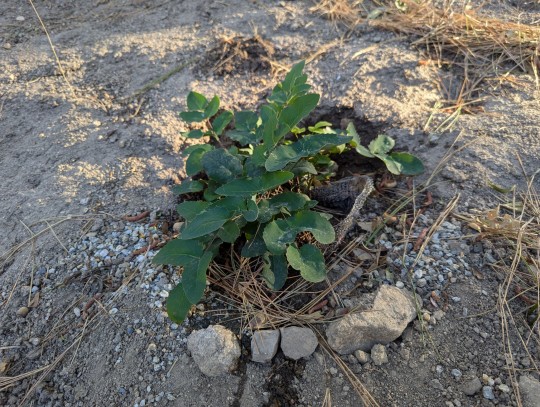
The Oregon Grape that I hope will mound and help hold up the hillside.
Please note that I'm not sure if this is the right way to plant on a slope like this or not, please do more research than I did when designing your own landscaping projects. 😆
Also probably should have done more research on the plant itself. This is another one that is native to Northern California instead of my particular area, unfortunately. Should have looked it up on CalScape before blowing $40 at the nursery. At least it shouldn't be outright invasive like it can be in other states.
#the constant dilemma with the term California natives#native to where exactly?#and will it fit in my particular crazy microclimate?#guess we'll find out
2 notes
·
View notes
Text
me when I’m back in Ireland and it’s a full ten degrees °C colder than in the south of France
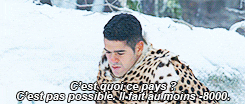
#(No there’s no snow but I was still Unprepared)#I was on the Côte d’Azur during the holidays and the NORMAL temperature there in late December is like 14°C#There’s a microclimate there#local French blogger now coming to you from ireland
14 notes
·
View notes
Text
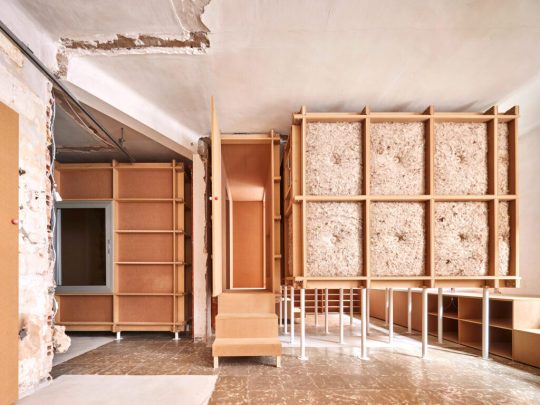
TAKK / 10K House / 2023 / Image © José Hevia
#takk#architecture#interior#mdf#wood#low cost#recycle#reuse#program#self building#domesticity#ruin#materiality#microclimate#superfurniture
3 notes
·
View notes
Text
Cities are home to all forms of life, not just humans
Urban Reef designs and creates open-ended habitats that encourage the growth and diversity of life in urban settings such as streetscapes, squares and buildings. To live together with more-than-human lifes, urban settings need more room for uncontrolled and emerging ecologies, both physically and in our collective thought.
Our prototypes called "Reefs" are designed to integrate open systems and regenerative design into the city. Reefs are created using bio-based algorithms and are 3D printed with (living) materials. Connected with passive flows rich in sunlight, water, nutrients and minerals, Reefs provide a range of microclimates and store nutrients that benefit more-than-human beings, complementing anthropocentric design approaches of urban environments.
This looks to be an interesting concept. This looks like it’s been official since 2022 (according to the website down towards the bottom) however a lot of stuff on the blog portion looks to have been made in October of this year (2023). So a lot of this is fairly new. It’ll be interesting to see how this grows once implemented into an actual urban setting. Will it be on a little patch of dirt where a tree might be by the sidewalk? Or just on cement? Makes me wonder how long this would break down since it’s made from materials like clay but also has seeds made throughout it. It’s also interesting to see what creatures would come to these reefs and if these creatures would deem it good enough for living in.
5 notes
·
View notes